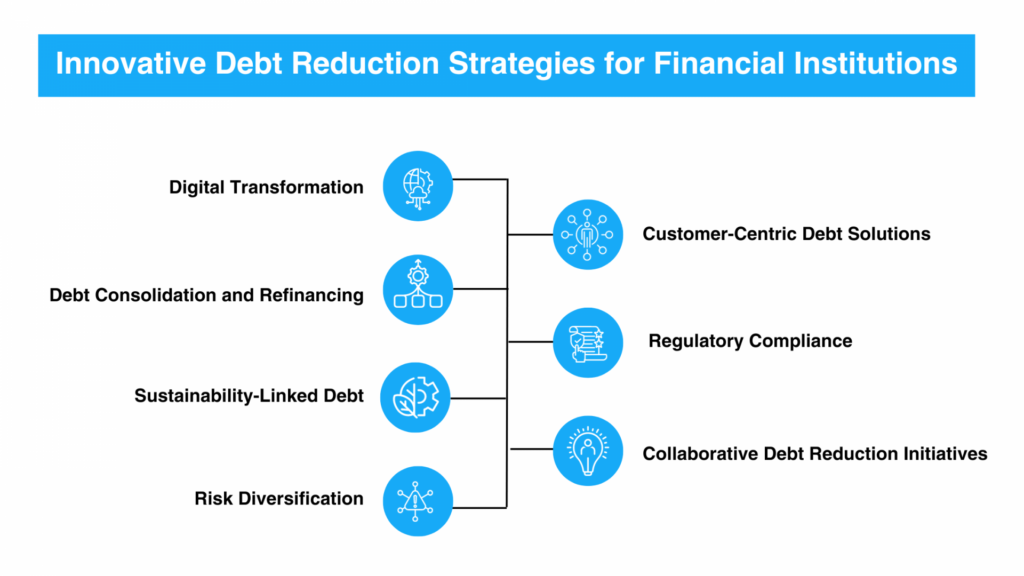Banking on Success: Innovative Debt Reduction Strategies for Financial Institutions
In today’s financial landscape, banks and other financial institutions face a significant challenge in managing and reducing debt while maintaining profitability. The burden of debt can undermine an institution’s stability and hinder its ability to provide essential financial services to customers.
To address this challenge, financial institutions must adopt innovative Debt reduction strategies to reduce debt effectively and sustainably.
In this article, we will explore some cutting-edge approaches that can help banks and financial institutions manage and reduce debt, ensuring their long-term success.

Digital Transformation
Digital transformation has become a buzzword in the banking industry, but its impact on debt reduction cannot be overstated. By embracing technological advancements, financial institutions can streamline their operations, reduce overhead costs, and optimize customer experiences.
a. Digital Lending Platforms: Implementing digital lending platforms can expedite the loan origination process, improve risk assessment, and enhance the overall efficiency of lending operations. Automated underwriting, AI-powered credit scoring, and blockchain-based smart contracts can reduce the risk of bad loans and defaults.
b. Debt Collection Automation: Modern debt collection and Debt reduction strategies leverage automation and data analytics to identify delinquent accounts more effectively. By using machine learning algorithms, financial institutions can prioritize collections efforts, reduce costs, and improve recovery rates.
Debt Consolidation and Refinancing
Debt consolidation and refinancing strategies can help financial institutions manage their debt portfolios more efficiently while minimizing risk.
a. Debt Consolidation: Financial institutions can consolidate their debt by bundling similar loans into packages with uniform terms and interest rates. This approach simplifies the management of debt portfolios, reduces administrative costs, and enhances risk management.
b. Refinancing Initiatives: Institutions can refinance existing debt to secure lower interest rates or extend repayment terms. This can lead to reduced debt service costs, making it easier to meet financial obligations.
Sustainability-Linked Debt
Sustainability-linked debt instruments have gained traction in recent years, as both borrowers and lenders recognize the importance of aligning financial activities with environmental, social, and governance (ESG) principles.
a. Green Bonds: Financial institutions can issue green bonds to raise capital for environmentally friendly projects. These bonds are tied to specific sustainability goals, and the institution commits to using the proceeds for approved green initiatives. This approach not only attracts socially responsible investors but also promotes sustainability efforts.
b. ESG-Linked Loans: Financial institutions can offer ESG-linked loans to clients that are actively working to improve their ESG performance. These loans typically offer favorable terms to borrowers who meet specific sustainability targets, incentivizing responsible business practices.
Risk Diversification
Diversification is a fundamental strategy for managing risk in financial institutions. By spreading the risk across different asset classes and industries, institutions can reduce their exposure to economic downturns and sector-specific challenges.
a. Portfolio Diversification: Financial institutions can diversify their loan portfolios by offering a variety of loan products, including mortgages, consumer loans, and business loans. This strategy helps balance risk and return, reducing the impact of defaults in any single category.
b. Geographic Diversification: Expanding operations into multiple geographic regions can reduce risk by minimizing exposure to localized economic downturns. It also allows institutions to tap into growth opportunities in different markets.
Customer-Centric Debt Solutions
Financial institutions can improve debt reduction efforts by offering customer-centric solutions that empower borrowers to manage their debt more effectively.
a. Financial Wellness Programs: Banks can provide financial education and wellness programs to help customers understand their financial situation better. These programs can include budgeting tools, debt consolidation options, and savings strategies.
b. Flexible Repayment Plans: Offering flexible repayment plans, such as income-driven repayment for student loans, can help borrowers avoid default and manage their debt load more effectively. These options can reduce delinquency rates and improve loan performance.
Regulatory Compliance
Staying compliant with evolving regulatory standards is essential for financial institutions. Non-compliance can lead to penalties, legal issues, and reputational damage.
a. Regulatory Technology (RegTech): Implementing RegTech solutions can help financial institutions streamline compliance efforts. These tools leverage artificial intelligence and data analytics to monitor regulatory changes, assess risk, and ensure adherence to evolving standards.
b. Stress Testing: Regular stress testing of debt portfolios can help institutions identify vulnerabilities and prepare for adverse economic scenarios. This proactive approach enhances risk management and ensures compliance with regulatory requirements.
Collaborative Debt Reduction Initiatives
Collaboration among financial institutions can yield innovative debt reduction strategies that benefit the industry as a whole.
a. Debt Buyback Programs: Financial institutions can collaborate to create debt buyback programs where they purchase each other’s distressed debt at a discounted rate. This approach can help institutions clean up their balance sheets while minimizing losses.
b. Data Sharing Consortia: Collaborative data sharing initiatives can improve credit risk assessment by providing access to a broader range of data points. Institutions can form consortia to share anonymized borrower data and gain insights that enhance lending and risk assessment practices.
Conclusion
Innovative debt reduction strategies are crucial for the long-term success and stability of financial institutions. By embracing digital transformation, sustainability-linked debt, risk diversification, customer-centric solutions, regulatory compliance, and collaborative initiatives, banks and financial organizations can better manage their debt portfolios, reduce risk, and provide sustainable financial services to their customers. As the financial industry continues to evolve, staying ahead of these trends will be essential to remaining competitive and resilient in a rapidly changing environment.
Try our Debt Resolution solutions today Request a Demo